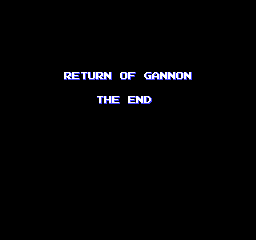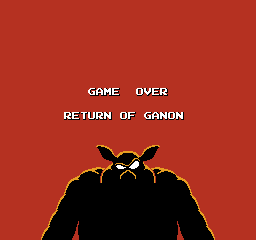The Adventure of Link Regional Differences: Difference between revisions
Jump to navigation
Jump to search

Want an adless experience? Log in or Create an account.
No edit summary |
|||
| Line 61: | Line 61: | ||
*While wandering in the Overworld, there are three different types of encounters. In the Famicom, these were represented by small ghost looking blobs, with weak encounters being a tan color, strong encounters being blue, and fairies being orange. In the NES version, these sprites were changed to make it much easier to understand which encounters were difficult, and when a Fairy is around. | *While wandering in the Overworld, there are three different types of encounters. In the Famicom, these were represented by small ghost looking blobs, with weak encounters being a tan color, strong encounters being blue, and fairies being orange. In the NES version, these sprites were changed to make it much easier to understand which encounters were difficult, and when a Fairy is around. | ||
<center>{| class="wikitable" | <center> | ||
{| class="wikitable" | |||
!Famicom || NES | !Famicom || NES | ||
|- | |- | ||
| Line 70: | Line 71: | ||
| [[File:Famicom-Fairy-Encounter.png]] || [[File:NES-Fairy-Encounter.png]] | | [[File:Famicom-Fairy-Encounter.png]] || [[File:NES-Fairy-Encounter.png]] | ||
|- | |- | ||
|}</center> | |} | ||
</center> | |||
{{References}} | {{References}} | ||
Revision as of 18:50, March 12, 2019
| This article is a stub. You can help the Zelda Dungeon Wiki by expanding it. |
The Adventure of Link was originally released on the Famicom Disk System in Japan during January of 1987. Over a year and a half later, it was released in Europe and the United States on the Nintendo Entertainment System and had a substantial number of differences. Below is a complete listing of all the regional differences of The Adventure of Link.[1]
Story
The introduction story of the Famicom Disk System has some English text and it is of significant difference than the NES version.
- Ganon is referred to as Gannon in the Famicom version, but is changed to Ganon in the NES version.
- The Famicom version refers to Another Sleeping Princess Zelda, where as the NES version simply refers to her as Princess Zelda. In this case the Famicom version is more appropriate, as the Zelda in Adventure of Link is a different Zelda than the one that appeared in The Legend of Zelda. She is the original Princess Zelda and all other girls born into the Royal Family after her are named Zelda. This change is likely just to provide ease of understanding of the story, where as the more detailed information is in the Instructional Manual.
- There are a number of spelling and grammatical errors, along with name changes, including the word Tryforce instead of Triforce, Disvalley instead of Valley of Death, and Great Sanctuary instead of Great Palace.
| Famicom | NES |
|---|---|
| SEVERAL YEARS AFTER GANNON WAS DESTROYED,LINK LEARNS FROM IMPA ABOUT THE ANOTH- ER SLEEPING PRINCESS ZELDA. HE IS TOLD SHE CAN ONLY AWAKEN WITH THE NO.3 TRY- FORCE SEALED IN THE GREAT SANCTUARY AT DISVALLEY. TO REMOVE THE SEAL, CRYSTALS MUST BE EMBEDDED INTO A STONE STATUE STANDING IN 6 SANCTUARIS. LINK SETS OUT ON AN ADVENTUROUS QUEST.... ©1987 NINTENDO |
AFTER GANON WAS DESTROYED, IMPA TOLD LINK A SLEEPING SPELL WAS CAST ON PRINCESS ZELDA. SHE WILL WAKE ONLY WITH THE POWER OF NO.3 TRIFORCE SEALED IN A PALACE IN HYRULE. TO BREAK THE SEAL,CRYSTALS MUST BE PLACED IN STATUES IN 6 WELL GUARDED PALACES. LINK SET OUT ON HIS MOST ADVENTURESOME QUEST YET... ©1987 NINTENDO |
Game Over
- The background of the Game Over screen on the Famicom version is simply just black, where it is Red with a silhouette of Ganon.
- The Famicom version has the spelling of Gannon instead of Ganon.
- In the Famicom version, the audio that plays here is almost an elephant sounding noise. It is a similar noise that can be heard during some of the boss battles, with Link fights Horsehead and Barba.
| Famicom | NES |
|---|---|
 |

|
North Castle
- At the very start of the game, the North Castle is decorated differently. In the NES version, the pillars continue off to the side of the alter until the end of the screen.
- There are two torches on the sides of Zelda. However, these torches are not found during the ending portion of the game.
| Famicom | 
|
| NES | 
|
Link Sprites
- In the NES Version, an additional pixel was adding to Link's base sprite, giving him more of a visual mouth.
- In the Famicom version, Link collected all items by stabbing them with his sword. This is similar to how Link collects all Keys, Point Bags, and Magic Jars in both versions of the game. However, in the NES version, Link can simply walk into some of the items and will pick them up. This caused two sprite images to appear more commonly in the NES version.
- Additionally, this change allows Link to use the Fairy Spell and still collect items. In the Famicom version, this was not possible, as Link needed to stab the items with his sword.
- A similar version of the sprite of Link holding up an object is still present in the Famicom version, as it is used at the very end of the game, when Link is holding the Triforce.
| Famicom | NES |
|---|---|
Overworld Enemy Sprites
- While wandering in the Overworld, there are three different types of encounters. In the Famicom, these were represented by small ghost looking blobs, with weak encounters being a tan color, strong encounters being blue, and fairies being orange. In the NES version, these sprites were changed to make it much easier to understand which encounters were difficult, and when a Fairy is around.
| Famicom | NES |
|---|---|


